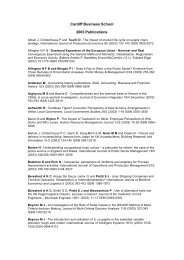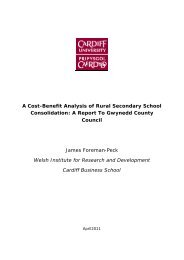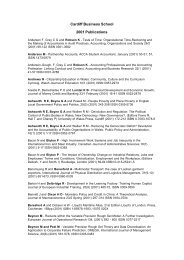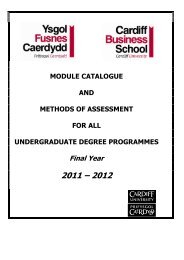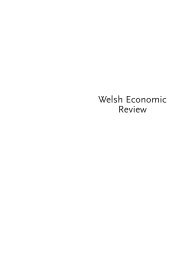Revisiting the Great Moderation using the Method of Indirect Inference
Revisiting the Great Moderation using the Method of Indirect Inference
Revisiting the Great Moderation using the Method of Indirect Inference
Create successful ePaper yourself
Turn your PDF publications into a flip-book with our unique Google optimized e-Paper software.
macro variance in <strong>the</strong> later period. If one <strong>the</strong>n examines which shocks' volatility fell, <strong>the</strong><br />
table (15) following shows that it did so for all three <strong>of</strong> our shocks, with a fall in standard<br />
deviation <strong>of</strong> 60-70%.<br />
If we look at <strong>the</strong> Taylor Rule model <strong>the</strong> story is essentially <strong>the</strong> same. As we saw above<br />
<strong>the</strong> ination response <strong>of</strong> <strong>the</strong> Taylor Rule hardly changes across <strong>the</strong> two periods. The main<br />
change is a doubling <strong>of</strong> <strong>the</strong> smoothing parameter which accordingly contributes about a<br />
third <strong>of</strong> <strong>the</strong> reduction in interest rate variance. O<strong>the</strong>rwise structural and policy parameter<br />
changes contribute negligibly to <strong>the</strong> variance reduction. Thus again <strong>the</strong> reduction in shock<br />
variability dominates as <strong>the</strong> cause <strong>of</strong> <strong>the</strong> <strong>Great</strong> <strong>Moderation</strong>. Here too all <strong>the</strong> shocks have<br />
large falls in standard deviation; <strong>the</strong> largest at 86% is <strong>the</strong> monetary shock (tables 16 and<br />
17).<br />
Table 14: Accountability <strong>of</strong> Factor Variations for Reduced Data Volatility<br />
(Timeless Rule model)<br />
Reduced data volatility<br />
caused by<br />
Interest rate Output gap Ination<br />
Reduced shocks 115.3% 106.9% 90%<br />
Chg in policy paras -4.3% -2.5% 12.7%<br />
Chg in structural para -11% -4.5% -2.7%<br />
Thus what we nd is that <strong>the</strong> <strong>Great</strong> <strong>Moderation</strong> is essentially a story <strong>of</strong> `good shocks'<br />
as proposed in <strong>the</strong> time-series studies we cited earlier. Also we have found no evidence <strong>of</strong><br />
<strong>the</strong> weak monetary regime regarded by an earlier DSGE model literature as responsible for<br />
<strong>the</strong> <strong>Great</strong> Acceleration and in <strong>the</strong> same vein no evidence <strong>of</strong> much change in <strong>the</strong> monetary<br />
regime during <strong>the</strong> <strong>Great</strong> <strong>Moderation</strong>. However, what we do nd about monetary policy<br />
is that <strong>the</strong> `trembling hand' trembled enormously more in <strong>the</strong> earlier period than in <strong>the</strong><br />
later; thus monetary error is a large source <strong>of</strong> <strong>the</strong> <strong>Great</strong> Acceleration and its reduction<br />
an important reason for <strong>the</strong> <strong>Moderation</strong>. For those that embrace a Taylor Rule model in<br />
spite <strong>of</strong> its poorer data t <strong>the</strong> story is <strong>the</strong> same|in this case monetary `judgement' was<br />
37



